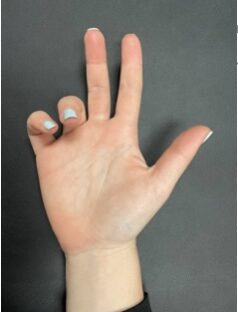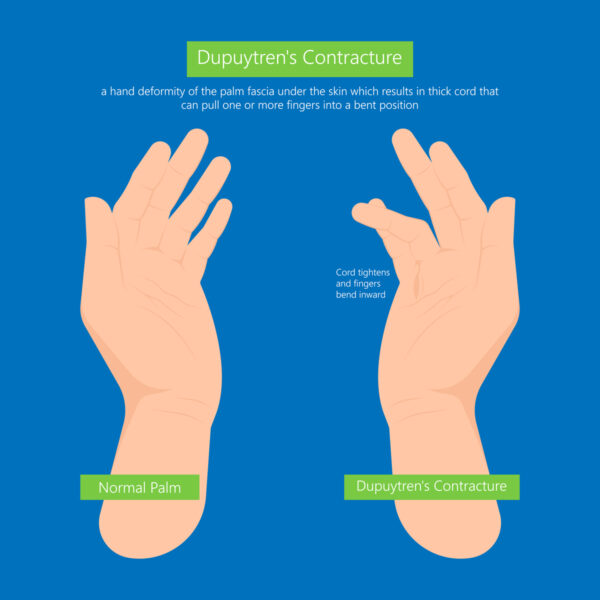
Picture to represent the fingers that are typically affected and position of the contracture
What is Dupuytren’s Contracture?
Dupuytren’s contracture is the thickening of the palmar fascia which usually affects the ring and small finger causing the fingers to contract, or flex towards the palm, making it difficult to complete gripping tasks or lay your hand flat. The abnormal thickening can create a hard lump or thick band on the palm side of the hand specific to the fingers affected.

Dupuytren’s Contracture Symptoms
The common symptoms can include:
- Inability to lay hand flat with all fingers extended
- Physical nodules or lumps that are hard at the base of the fingers on the palm side
- Affected fingers physically flexed towards palm with decreased ability to extend the fingers
- Physical tightening of the skin with grooves compressed by contracted fingers
- Tenderness that usually goes away with time at the palm side of the fingers
- Burning sensation in the palm
Causes of Dupuytren’s Contracture
There is currently no known cause of the disease, however the contracture has been associated to be hereditary in nature.
Risk factors for developing Dupuytren’s includes:
- Age as the condition typically starts in middle age
- Sex as male are more common than female
- Ethnicity as Scandinavian or Northern European background is statistically more likely to occur with families from these regions
- Genetics as family history of disease can increase likelihood
- Certain medications such as epileptic seizure medication
- Past medical history such as diabetes
- Smoking and alcohol abuse
Conservative Treatment for Dupuytren’s Contracture
Dupuytren’s contracture cannot be cured however depending on the severity of the contracture you may continue to be able to complete everyday activities. Should symptoms progress then your healthcare provider may provide you with a brace to keep the affected fingers extended as much as possible and your occupational therapist may suggest exercises which stretch and strengthen the affected hands and fingers. Additionally built up handles may be suggested for activity modification.
Please seek medical attention if there is any change in functional use of your hand as it pertains to Dupuytren’s contracture.
What Does Dupuytren’s Contracture Surgery Look Like?
In the cases of severe contracture, surgery may be warranted to improve the mobility of the fingers by creating an incision in the hand to remove the thickened fascia tissue. There is a chance that the contracture can return with surgery.
Additionally, you may receive a steroid injection to the lump or nodules if pain is present, radiation therapy for early stages of the disease (not very common in US), enzyme injection to break down/dissolve the tough bands, and/or needle aponeurotomy to divide the stiff tissue in the hand.
Precautions/Contraindications?
As the disease progresses it may become more difficult to open your hand fully or grasp different items. It can be important to avoid using a tight grip, or using padded gloves during these gripping tasks in order to reduce the effects of the disease and to improve functional use of the hand and fingers. Heed the advice from your healthcare provider and wear your brace based on the recommendations from your occupational therapist.
References:
https://www.mayoclinic.org/diseases-conditions/dupuytrens-contracture/symptoms-causes/syc-20371943
A little bit about Amy Eckert, our visiting OT student…






